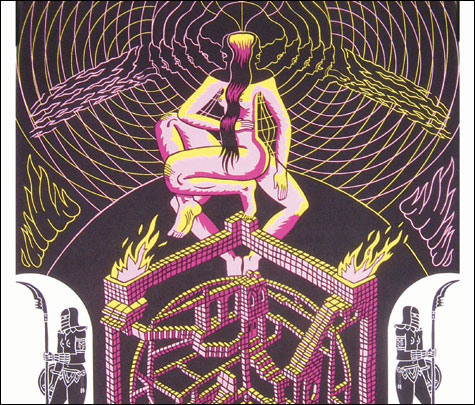An interview with Chad Verrill of CVIC works
By IAN PAIGE | November 12, 2008

"THROMMING GODDESS" A Chad Verrill illustration/woodcut/allegory. |
| "Consumption" | drawings and prints by Chad Verrill | through November 30 | at Front Room Gallery, 378 Cottage Road, South Portland | 207.767.9070 |
Chad Verrill, 34, makes drawings and prints at his home in Portland, where he's lived since he arrived in 1992 for a short-lived stint at the Portland School of Art. The sole proprietor of CVIC Works, he's arguably one of Maine's best illustrators and undeniably the state's most intriguing. His new show at Front Room Gallery in South Portland, "Consumption," shows a maturation of his unique style: part manuscript illumination, woodcut, and comic book all drenched in mysterious allegorical themes.LOOKING AT YOUR WORK, I IMAGINE YOU'VE BEEN DRAWING ALL YOUR LIFE. AT WHAT POINT DID YOU MAKE A TRANSITION INTO A MORE PROFESSIONAL APPROACH TO YOUR WORK? I work on drawing enough to call it a full-time job and, yes, I've been drawing since I was five or so. Comic books and cartoons were a big thing. In high school, I transitioned from the really nerdy stuff to the normal teenage, wrist-slashing surrealism artwork. In the last ten years, I've gelled a style based on various inspirations. As much as I'd like to stop, it's an obsession.
YOU WERE AN ILLUSTRATOR AT THIS PUBLICATION FOR A TIME. DO YOU STILL WORK IN THAT CONTEXT? I don't. I realized that wasn't the way I was intended to make money. I realized that by doing all this illustration, I was spending all my time promoting that I could draw a guy sitting at a laptop rather than promoting what I really want to draw. I eventually decided I wouldn't try to be an illustrator and instead try to make the art I wanted to make.
THIS IDEA THAT YOU CAN'T STOP DRAWING — THERE'S A SENSE THAT YOU ARE PLUMBING YOUR SUBCONSCIOUS IN EACH PIECE. The artwork becomes its own beast. That's part of why illustration didn't work for me. To make the concessions necessary to make it the next Hello Kitty sticker is ... I don't want to sit down and decide to make commercial work. Even though I do want it to be successful! You probably noticed at the show that my prices for prints are pretty cheap. In that way, I am a commercial artist. Simple work that people like ourselves can afford.
AND YET, THERE IS A LINE YOU'VE CROSSED SUCH THAT YOU CAN EXHIBIT THIS BODY OF WORK AS FINE ART. WHEN DO YOU THINK THAT TRANSITION OCCURRED? I think that, in 2008, we've come to a different point where artists can show work on paper which, ten years ago, was not as okay to do. In a lot of big cities, you can go to a gallery now and someone has torn all the pages out of their sketchbook, taped it up to the wall and people are amazed by it. It's okay to draw with markers, it's okay to draw on lined paper. Ten years ago, I wanted to make larger, fine-art pieces, nicely framed. Now I'm at the point where, if I sit down and draw something, that is the art I intended to make.
 Related
Related:
A mill grows in Biddeford, We heart these people, Deep cuts, More 
- A mill grows in Biddeford
'We're responding every step of the way to our environment. And to each other.'
- We heart these people
We all know Portland is a busy, exciting place to live. It takes a lot of people's amazing energy to keep it going, though. Who's doing the moving and the shaking?
- Deep cuts
The beauty of Kara Walker's silhouettes lies in their concurrent brutality and daintiness, and in her unabashed exploration cutting to the meat of the black-and-white binary in American contemporary culture.
- Allegorical expressions
Horses break loose from carnival carousels and run free, a horse-headed naked woman cuddles a rabbit as blue birds circle, and an escaped carousel horse visits the grave of a flower in Providence artist Lydia Stein's exhibit "Love Songs, Hobos & Other Spirits" at AS220's Project Space.
- Review: Neil Young Trunk Show
If a Neil Young neophyte can find himself rocking in a cinema seat to the spirited, soulful music performed in this second of a rumored triptych of Demme-directed, Young-starring concert documentaries, long-time fans are bound to break their armrests.
- Interview and photos: Gerard Malanga
In Walt Whitman’s notebook for the 1855 edition of Leaves of Grass , he writes, “Every soul has its own individual voice.” That notion rang true for photographer/poet/filmmaker Gerard Malanga as he put together “Souls,” an exhibit of 100 portraits spanning five decades.
- Slideshow: The Maya And The Mythic Sea at Peabody Essex Museum
Mayan works of art at the “Fiery Pool: The Maya And The Mythic Sea,” exhibit
- Random stuff
If you were going to create a portrait of the Internet, what would it look like?
- Review: Diary Of A Wimpy Kid
Middle-school antihero Greg Heffley may depict himself as a comic illustration in Jeff Kinney’s bestselling kids’ books, but director Thor Freudenthal turns him into an outright caricature.
- Photos: Art from paper bags
Photos from the GASP Gallery's 5th anniversary gala, Bag It!
- Review: The Art Of The Steal
Henri Matisse once declared the Barnes Foundation "the only sane place to see art in America."
- Still life
Nobody knew very much about Mike Disfarmer. Even his name was a fabrication.
- Less

 Topics
Topics:
Museum And Gallery
, Visual Arts, Chris Ware